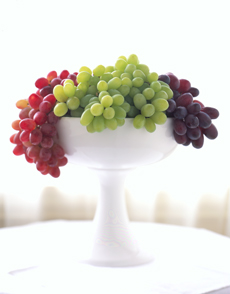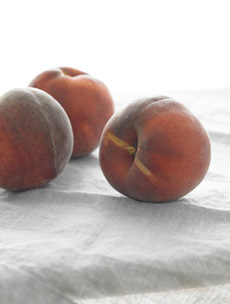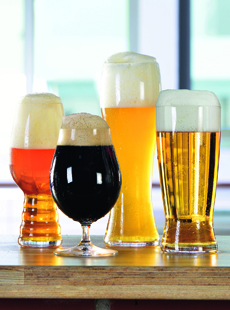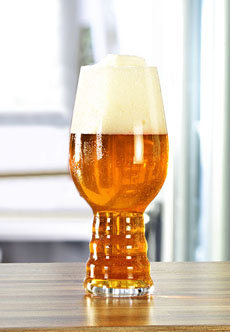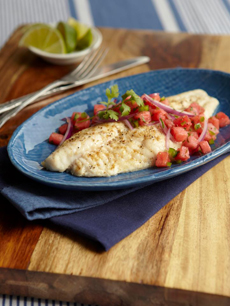|
Last week we presented two irresistible heirloom cucumbers.
This week’s noteworthy produce comprises red lettuce varieties we discovered while perusing the “produce section” on Burpee.com.
YUGOSLAVIAN RED LETTUCE
Burpee calls Yugoslavian Red Lettuce “perhaps the most beauteous lettuce we’ve grown: a star selection for your salad bowl.”
With bright-green cupped leaves splashed with rose-red and hints of yellow and orange, this butterhead type of lettuce makes a visual and flavorful splash in the salad bowl. Sure, you can tear the gorgeous leaves into bite size pieces. But we’d lay the whole leaves on a plate and use them as a pretty cup to hold other salads, from tuna to rice.
The taste is superb, buttery and mild. The lettuce can be harvested in about 55 days. Get ready to plant and don’t worry about having too much: Heads of this glorious lettuce make beautiful gifts.
|
|
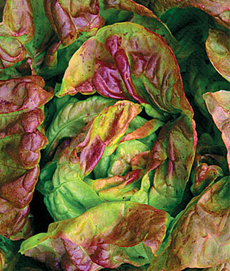
Dazzling: Yugoslavian red lettuce (photo © and seeds available at Burpee).
|
CIMARRON RED ROMAINE LETTUCE
Red romaine is a bit easier to find in specialty produce markets, along with red leaf lettuce.
Burpee’s Cimarron (photo below) is an heirloom red romaine with terrific flavor. It has been grown in America since the 1700s.
We seek out red leaf lettuces for Christmas salads, but this deep-red-going-on bronze beauty has a place at the table all year long.
We also found this red iceberg lettuce: Imagine a wedge ith blue cheese dressing!
WAYS TO ENJOY LETTUCE
Lettuce is most often used for salads and on sandwiches and as wraps. But you can grill it as a side, make lettuce soup and use it as a wrapper for Korean barbecue: hibachi-grilled beef, chicken or seafood rolled in a lettuce leaf with condiments.
Lettuce is a good source of vitamin A and potassium, as well as a minor source for several other vitamins and nutrients. Generally, the deeper the color, the more nutrients. Romaine, the most nutritious lettuce, has more folate (a B vitamin), vitamin K and lutein (an antioxidant related to vitamin A).
|
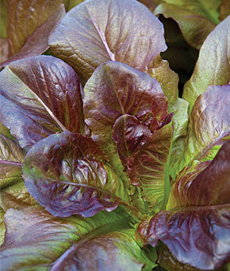
Cimarron red romaine (photo © and seeds available at Burpee). |
|
THE HISTORY OF LETTUCE & TYPES OF LETTUCE
Lettuce (Lactuca sativa) was first cultivated in ancient Egypt. Egyptian farmers developed it—from a weed whose seeds were used to produce oil into a plant grown for its tasty leaves.
Lettuce was carried home by Greeks and Romans. The Romans called it lactuca, the Latin word for milk, referring to the white substance that exuded from the cut stems. (Sativa, which means sown or cultivated, is the species name for numerous types of produce.)
Our word lettuce came to Middle English from the Old French letues or laitues. The name romaine came from that variety’s use in the Roman papal gardens, while cos, another term for romaine lettuce, came from the Greek island of Cos, a center of lettuce farming in the Byzantine period.
|
By 50 C.E., there are descriptions of multiple varieties of lettuce. Over the centuries, many varieties were developed in Europe. Today, it is cultivated around the world: More than half of world production comes from China. (Source: Wikipedia)
TYPES OF LETTUCE
There are seven main cultivar groups of lettuce, each of which includes numerous varieties. Three types—cos or romaine, head and leaf lettuces—are the most common.
Butterhead lettuce. Also known as Boston or Bibb lettuce, this type head lettuce has a loose arrangement of leaves, sweet flavor and tender texture. Along with crisphead lettuce, it is also known as cabbage lettuce because the heads are shorter, flatter and more cabbage-like than romaine lettuces.
Crisphead lettuce. Better known as iceberg lettuce, crisphead is the most popular lettuce—much to the chagrin of those who declaim its limited flavor and low nutritional content. It has a higher percentage of water than other lettuce types. It’s a relatively recent cultivar: Here’s the history of iceberg lettuce.
Leaf lettuce. Also known as looseleaf, cutting or bunching lettuce, this type has loosely bunched leaves. It is used mainly for salads.
Oilseed lettuce. The original lettuce, oilseed has few leaves. It is grown for its seeds, which are pressed to extract a cooking oil. The seeds are about twice the size of other lettuce seeds.
Romaine/Cos lettuce. This variety forms long, upright heads that are used mainly for salads and sandwiches.
Stem lettuce. Stem lettuce is grown for its seedstalk, rather than its leaves. The long, thin stalks (think asparagus) are used in Chinese cooking.
Summercrisp lettuce. Also called Batavian or French Crisp lettuce, this group falls midway between the crisphead and leaf types.
On your next trip to a farmers market or specialty produce store, see how many of these seven lettuce types you can find.
|
|

